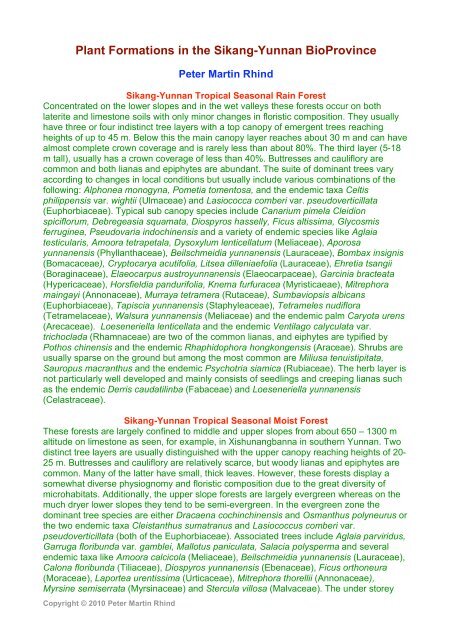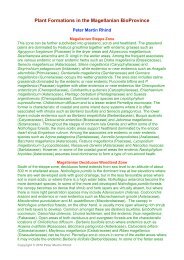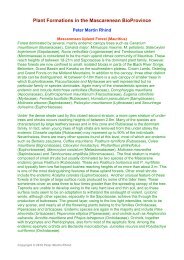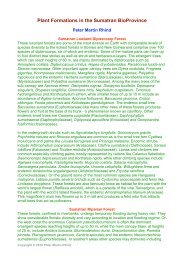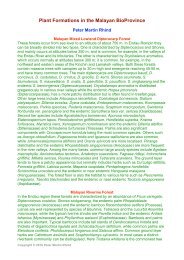Sikang-Yunnan Vegetation - Terrestrial Biozones
Sikang-Yunnan Vegetation - Terrestrial Biozones
Sikang-Yunnan Vegetation - Terrestrial Biozones
Create successful ePaper yourself
Turn your PDF publications into a flip-book with our unique Google optimized e-Paper software.
Plant Formations in the <strong>Sikang</strong>-<strong>Yunnan</strong> BioProvince<br />
Copyright © 2010 Peter Martin Rhind<br />
Peter Martin Rhind<br />
<strong>Sikang</strong>-<strong>Yunnan</strong> Tropical Seasonal Rain Forest<br />
Concentrated on the lower slopes and in the wet valleys these forests occur on both<br />
laterite and limestone soils with only minor changes in floristic composition. They usually<br />
have three or four indistinct tree layers with a top canopy of emergent trees reaching<br />
heights of up to 45 m. Below this the main canopy layer reaches about 30 m and can have<br />
almost complete crown coverage and is rarely less than about 80%. The third layer (5-18<br />
m tall), usually has a crown coverage of less than 40%. Buttresses and cauliflory are<br />
common and both lianas and epiphytes are abundant. The suite of dominant trees vary<br />
according to changes in local conditions but usually include various combinations of the<br />
following: Alphonea monogyna, Pometia tomentosa, and the endemic taxa Celtis<br />
philippensis var. wightii (Ulmaceae) and Lasiococca comberi var. pseudoverticillata<br />
(Euphorbiaceae). Typical sub canopy species include Canarium pimela Cleidion<br />
spiciflorum, Debregeasia squamata, Diospyros hasselly, Ficus altissima, Glycosmis<br />
ferruginea, Pseudovaria indochinensis and a variety of endemic species like Aglaia<br />
testicularis, Amoora tetrapetala, Dysoxylum lenticellatum (Meliaceae), Aporosa<br />
yunnanensis (Phyllanthaceae), Beilschmeidia yunnanensis (Lauraceae), Bombax insignis<br />
(Bomacaceae), Cryptocarya acutifolia, Litsea dilleniaefolia (Lauraceae), Ehretia tsangii<br />
(Boraginaceae), Elaeocarpus austroyunnanensis (Elaeocarpaceae), Garcinia bracteata<br />
(Hypericaceae), Horsfieldia pandurifolia, Knema furfuracea (Myristicaeae), Mitrephora<br />
maingayi (Annonaceae), Murraya tetramera (Rutaceae), Sumbaviopsis albicans<br />
(Euphorbiaceae), Tapiscia yunnanensis (Staphyleaceae), Tetrameles nudiflora<br />
(Tetramelaceae), Walsura yunnanensis (Meliaceae) and the endemic palm Caryota urens<br />
(Arecaceae). Loeseneriella lenticellata and the endemic Ventilago calyculata var.<br />
trichoclada (Rhamnaceae) are two of the common lianas, and eiphytes are typified by<br />
Pothos chinensis and the endemic Rhaphidophora hongkongensis (Araceae). Shrubs are<br />
usually sparse on the ground but among the most common are Miliusa tenuistipitata,<br />
Sauropus macranthus and the endemic Psychotria siamica (Rubiaceae). The herb layer is<br />
not particularly well developed and mainly consists of seedlings and creeping lianas such<br />
as the endemic Derris caudatilinba (Fabaceae) and Loeseneriella yunnanensis<br />
(Celastraceae).<br />
<strong>Sikang</strong>-<strong>Yunnan</strong> Tropical Seasonal Moist Forest<br />
These forests are largely confined to middle and upper slopes from about 650 – 1300 m<br />
altitude on limestone as seen, for example, in Xishunangbanna in southern <strong>Yunnan</strong>. Two<br />
distinct tree layers are usually distinguished with the upper canopy reaching heights of 20-<br />
25 m. Buttresses and cauliflory are relatively scarce, but woody lianas and epiphytes are<br />
common. Many of the latter have small, thick leaves. However, these forests display a<br />
somewhat diverse physiognomy and floristic composition due to the great diversity of<br />
microhabitats. Additionally, the upper slope forests are largely evergreen whereas on the<br />
much dryer lower slopes they tend to be semi-evergreen. In the evergreen zone the<br />
dominant tree species are either Dracaena cochinchinensis and Osmanthus polyneurus or<br />
the two endemic taxa Cleistanthus sumatranus and Lasiococcus comberi var.<br />
pseudoverticillata (both of the Euphorbiaceae). Associated trees include Aglaia parviridus,<br />
Garruga floribunda var. gamblei, Mallotus paniculata, Salacia polysperma and several<br />
endemic taxa like Amoora calcicola (Meliaceae), Beilschmeidia yunnanensis (Lauraceae),<br />
Calona floribunda (Tiliaceae), Diospyros yunnanensis (Ebenaceae), Ficus orthoneura<br />
(Moraceae), Laportea urentissima (Urticaceae), Mitrephora thorellii (Annonaceae),<br />
Myrsine semiserrata (Myrsinaceae) and Stercula villosa (Malvaceae). The under storey
consists of many saplings and creeping lianas such as Hiptage benhalensis and the<br />
endemic Loeseneriella yunnanensis (Celastraceae), and many herbaceous elements<br />
particularly members of the family Urticaceae such as species of Elatostema and Pilea,<br />
and the endemic Procris crenata (Urticaceae). In the semi-evergreen zones the upper<br />
canopy is usually deciduous and typically dominated by endemic taxa like Bombax insignis<br />
(Bombacaceae), Calona floribunda (Tiliaceae), Garcinia bracteata (Hypericaceae) and<br />
Tetrameles nudiflora (Tetramelaceae), while the second layer is largely evergreen. Other<br />
associated trees include Eriolaena kwangsiensis, Erythrina lithosperma, Hymenodictyon<br />
excelsum, Kydia calycina, Lagerstroemia venusta, Radermachera microcalyx, Spondias<br />
pinnata and several endemic taxa such as Millettia tetraptera (Fabaceae) and Pistacia<br />
weinmannifolia (Anacardiaceae). The under storey consists of shrubs such as the endemic<br />
Colebrookea oppositifolia (Lamiaceae) and Murraya koenigii (Rutaceae), and creeping<br />
lianas like the endemic Amalocalyx yunnanensis (Apocynaceae), but epiphytes are<br />
infrequent.<br />
<strong>Sikang</strong>-<strong>Yunnan</strong> Montane Dwarf Forest<br />
Occurring on limestone hill and mountaintops of Xishuangbanna in southern <strong>Yunnan</strong><br />
between 900-1600 m these stunted forests grow to no more than about 15 m in height.<br />
They usually have just one tree layer but may form both evergreen and semi-evergreen<br />
stands depending on moisture levels. The dominant or co-dominant trees include<br />
Dracaena cochichinensis and Ficus neriifolia in the semi-evergreen zones and the<br />
endemic Myrsine semiserrata (Myrsinaceae) and Pistacia weinmannifolia (Anacardiaceae)<br />
in the evergreen zones. Other characteristic tree species include the endemic<br />
Pterospermum proteus (Malvaceae). Epiphytes are very common with many orchids such<br />
as Bulbophyllum nigrescesns and Eria hainanensis, and a variety of bryophytes and<br />
lichens. Among the typical under storey species is the strange endemic Agapetes<br />
burmanica (Ericaceae) with its distinctive swollen, water storage roots. Less common<br />
species are Clematis kerrii, Fagopyrum tataricum, Kalanchoe laciniata and several<br />
endemics such as Bauhinia carcinophylla (Fabaceae), Peperomia heyneana (Piperaceae),<br />
Pilea platanifolia (Urticaceae) and Tetrastigma delavayi (Vitaceae).<br />
<strong>Sikang</strong>-<strong>Yunnan</strong> Montane Evergreen Oak Forest<br />
Forest dominated by the evergreen oak Quercus longispica typically occur below the Abies<br />
forest of <strong>Yunnan</strong> and range in altitude from about 2400 – 3200 m. The canopy is usually<br />
quite low (about 8 m) but very dense with crowns of tree closely touching. Associated trees<br />
may include Acer wardii, Cyclobalanus glauca, Magnolia globosa, Pasania leucostachya,<br />
Quercus griffithii, Q. serrata, Q. variabilis and Sloana forrestii. The trees are often crooked<br />
and festooned with beard lichens such as Usnea longissima. Other epiphytes are common<br />
especially the epiphytic fern Drynaria delavayi that adorns virtually every tree, and<br />
climbers such as Akebia trifoliate and Ampelopsis heterophylla may also be encountered.<br />
The rich shrub layer is often dominated by Pittosporum heterophyllum var. ledoides, but<br />
many other species like Euptelea franchetii, Lonicera koehneana, Prunus pilosiuscula,<br />
Ribes tenue and Stachyurus chinensis occur. Despite the fact that the forest floors are<br />
often covered in a thick layer of fallen leaves the ground layer flora is very rich. Other<br />
endemic taxa associated with these forests include Cercis yunnanensis (Fabaceae),<br />
Machilus yunnanensis var. duclouxiana (Lauraceae) and Michelia yunnanensis<br />
(Magnoliaceae).<br />
<strong>Sikang</strong>-<strong>Yunnan</strong> Montane Coniferous Forest<br />
Montane forests dominated by conifers can be found in eastern <strong>Sikang</strong> and northwestern<br />
<strong>Yunnan</strong>. In the latter they are chiefly dominated by the endemic Abies delavayi (Pinaceae),<br />
whereas in <strong>Sikang</strong> Abies squamata and the endemic Picea likiangensis (Pinaceae) usually<br />
Copyright © 2010 Peter Martin Rhind
dominate. In other respects they are similar and among the less common conifers are<br />
various endemic species such as Abies forrestii (Pinaceae), Pinus yunnanensis<br />
(Pinaceae) and Tsuga yunnanensis (Pinaceae). Of considerable geobotanical interest is<br />
the presence of the ancient relict conifers Metasequoia glyptostroboides (Cupressaceae)<br />
and Taiwania cryptomerioides (Cupressaceae). Originally Taiwania was thought to be<br />
confined to Taiwan, but relict stands were discovered along the sheltered sides of valleys<br />
above 2000 m in the upper Chiu-Kiang, Nu-Kiang and other places. It is a forest giant<br />
towering above the forest canopy. Trees of Metasequoia (dawn redwood) are thought to<br />
be the remnants of an extensive ancient forest of giant conifers contemporaneous with the<br />
giant redwoods of the New World. Many of these often isolated conifer forests are in a<br />
completely natural state stocked with many old and mature trees. The tree are often<br />
covered in a thick layer of bryophytes and draped with beard lichen (Usnea longissima)<br />
giving the canopy a grayish appearance. At ground level the vegetation is varied and<br />
maybe completely absent in some of the denser stands where there are thick layers of<br />
fallen needles. In other places scattered shrubs of Cotoneaster, Rubus or Spiraea may be<br />
present or herbaceous species like Beesia calthaefolia, Bergenia purpuracens, Berneuzia<br />
thibetica, Cardamine macrophy, Circaeaster agrestis, Clintonia udensislla, Corydalis<br />
cheirifolia, Hemiphragma heterophyllum and Tiarella polyphylla.<br />
Copyright © 2010 Peter Martin Rhind<br />
References<br />
Averyanov, L. V., Phan Ke Loc, Nguyen Tien Hiep, Harder, D. K. 2003. Phytogeographic<br />
review of Vietnam and adjacent areas of Eastern Indochina. Komarovia, 3: 1-83.<br />
Cao, M. & Zhang J. 1997. Tree species diversity of tropical forest vegetation in<br />
Xishuangbanna, SW China. Biodiversity and Conservation, 6: 995-106.<br />
Ji, Z., Guangmei, Z., Huadong, W. & Jialin, X. 1990. The Natural History of China. Collins.<br />
Hou, H. Y. 1983. <strong>Vegetation</strong> of China with references to its geographical distribution.<br />
Annals of the Missouri Botanical Garden, 70: 509-549.<br />
Li, Liang-quan. 2009. A floristic study of the upper reaches of the Hougshui River,<br />
southwestern China. Laboratory of Systematic and Evolutionary Botany and Herbarium,<br />
Institute of Botant, Academia Sinica, Beijing, China.<br />
López-Pujol, J., Zhang, F-M., Ge, S. 2006. Plant biodiversity in China: richly varied,<br />
endangered, and in need of conservation. Biodiversity and Conservation, 15: 3983-4026.<br />
Songqiao, Z. & Huaxun, L. 1989. Shrublands of China. In: The Biology and Utilization of<br />
Shrubs. Ed. C. M. McKell. Academic Press, Inc.<br />
Yuming Yang, Kun Tian, Jiming Hao, Shengji Pei & Yongxing Yang 2004. Biodiversity and<br />
biodiversity conservation in <strong>Yunnan</strong>, China. Biodiversity and Conservation, 13: 813-826.<br />
Zhang, J. & Cao, M. 1995. Tropical forest vegetation of Xishuangbanna, SW China and its<br />
secondary changes with special reference to some problems in local nature conservation.<br />
Biological Conservation, 73: 229-238.<br />
Zhu, H. 1997. Ecological and biogeographical studies on the tropical rain forest of south<br />
<strong>Yunnan</strong>, SW China with a special reference to its relation with rain forest of tropical Asia.
Journal of Biogeography, 24: 647-662.<br />
Zhu, H., Hong, W. & Baogui, L. 1998. The structure, species composition and diversity of<br />
the limestone vegetation in Xishuangbanna, SW China. Gardens’ Bulletin Singapore, 50:<br />
5-30.<br />
Zhu, H., Wang, H., Li, B. & Sirirugsa, P. 2003. Biogeography and floristic affinities of the<br />
limestone flora in southern <strong>Yunnan</strong>, China. Annals of the Missouri Botanical Garden, 90,<br />
444-465.<br />
Zhang, Yin-Bo & Ma Ke-Ping. 2008. Geographic distribution pattern and status<br />
assessment of threatened plants in China. Biodiversity and Conservation, 17: 1738-1798.<br />
Copyright © 2010 Peter Martin Rhind


